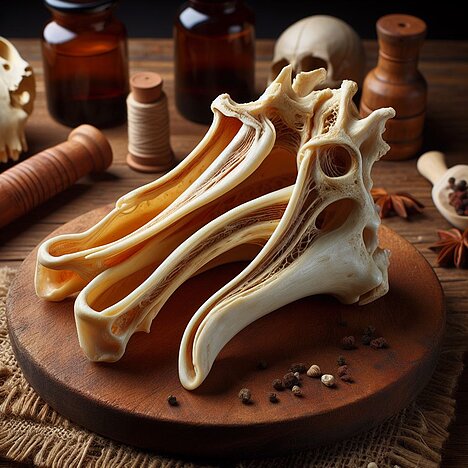Goat's neck

What is goat fatback?
Goat larynx is a part of the offal of goats. It is the larynx with the epiglottis, trachea and hyoid bone. Goat larynx is usually offered dried or frozen and can be fed whole or cut into pieces.
What are the benefits of goat's larynx for dogs?
Goat's larynx has several benefits for your dog's health and well-being. Firstly, it is a good source of high-quality protein, which is important for muscle building and regeneration. Secondly, it contains many minerals such as calcium, phosphorus, magnesium and iron, which ensure strong bones and teeth. Goat's throat is also rich in cartilage and connective tissue, which lubricate the joints and support the skin and coat.
Goat's Throat also has a positive effect on your dog's digestion. It stimulates gastrointestinal activity and promotes intestinal flora. It can also help to prevent tartar by mechanically cleaning the teeth.
Last but not least, goat's throat is a tasty and varied snack for your dog that offers him lots of chewing fun. It is a good alternative to other chews such as beef ears or pig ears, which are often contaminated with hormones or antibiotics.
What are the disadvantages of goat larynx for dogs?
Goat's Throat also has some disadvantages that you should be aware of. On the one hand, allergic reactions can occur if your dog is sensitive to goat meat. On the other hand, injuries to the mouth or digestive tract can occur if your dog chews too hastily or swallows too large pieces. You should therefore always keep an eye on your dog when he is eating goat's throat and provide him with plenty of water.
You should also make sure that you only feed goat's throat in moderation. Too much can lead to an oversupply of calcium, which upsets the calcium-phosphorus ratio in the body. This can lead to growth disorders, especially in puppies or young dogs. As a rule of thumb, you should not cover more than 10 percent of your dog's daily energy requirements with bones.
How do you feed goat's throat correctly?
If you want to feed your dog goat's head, you should follow a few tips:
- Introduce goat's fathead slowly into your dog's diet. Start with small amounts and gradually increase them.
- Pay attention to the quality of the product. Only buy goat's larynx from trustworthy suppliers who pay attention to animal welfare and slaughter.
- Store goat's larynx correctly. If you buy dried goat larynx, store it in an airtight container in a cool, dry place. If you buy frozen goat fathead, thaw it slowly in the refrigerator and use it within two days.
- Only feed goat's head as a snack between meals and not as a main meal. If necessary, reduce the amount of normal food on the day you give goat's larynx.
- Always offer your dog fresh water when he eats goat's head.
Goat's Throat is a healthy and natural snack for your dog that offers him many benefits. It is a good source of protein, minerals, cartilage and connective tissue. It promotes your dog's digestion, dental health and well-being.
However, you should also be aware of some disadvantages. Goat's head can lead to allergic reactions or injuries if your dog is sensitive to it or eats it too greedily. You should also not feed too much of it to avoid an oversupply of calcium.
If you notice any signs of hypersensitivity or poisoning in your dog, you should see your vet immediately. We are not a substitute for a vet, but we try to be as accurate as possible. Every dog reacts differently and we recommend you get a second opinion or consult your vet if in doubt.
Stay healthy and take good care of your four-legged friend!😊